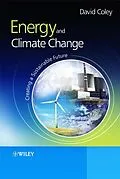For more information on this title, including student exercises, please visit, http://www.people.ex.ac.uk/DAColey/
Energy and Climate Change: Creating a Sustainable Future provides an up-to-date introduction to the subject examining the relationship between energy and our global environment. The book covers the fundamentals of the subject, discussing what energy is, why it is important, as well as the detrimental effect on the environment following our use of energy. Energy is placed at the front of a discussion of geo-systems, living systems, technological development and the global environment, enabling the reader to develop a deeper understanding of magnitudes.
Learning is re-enforced, and the relevance of the topic broadened, through the use of several conceptual veins running through the book. One of these is an attempt to demonstrate how systems are related to each other through energy and energy flows. Examples being wind-power, and bio-mass which are really solar power via another route; how the energy used to evaporate sea water must be related to the potential for hydropower; and where a volcano's energy really comes from.
With fermi-like problems and student exercises incorporated throughout every chapter, this text provides the perfect companion to the growing number of students taking an interest in the subject.
Autorentext
David Coley is the author of Energy and Climate Change: Creating a Sustainable Future, published by Wiley.
Klappentext
Over the past twenty years or so, interest in energy, both in the abstract and in humankind's use of it, has been brought to the fore, especially since concerns over climate change have become more widely reported.
Energy and climate change discusses what energy is, why it is important, our current energy systems and more sustainable alternatives, and why energy use is having a detrimental effect on the environment. Energy is placed at the front of a discussion of the global environment, technology and civilisation.
Problem solving is a central tool and is approached through the use of Fermi-like problems, where the reader is encouraged to explore relevant issues through simple numeric problem solving.
- Covers climate change, current energy technologies (e.g oil, gas, etc), renewable/alternative technologies, energy economics and the history of energy use
- Contains numerous student exercises and case-studies from around the world
- An invaluable text for those students taking courses in the physical sciences, engineering, earth and environmental sciences, geography and related subjects.
- Reflects on the international community and its attempts to solve the problem of climate change
- Additional teaching resources and weblinks available on the book's website www.wileyeurope.com/college/coley
Inhalt
Preface.
1. Introduction.
Part I: Energy: concepts, history and problems.
2. Energy.
What is energy?
Units.
Power.
Energy in various disguises.
Energy quality and exergy.
Student exercises.
3. The planet's energy balance.
The sun.
The earth.
Comparisons.
Student exercises.
4. A history of humankind's use of energy.
Energy and society.
Wealth, urbanization and conflict.
Our current level of energy use.
Student exercises.
5. Sustainability, climate change and the global environment.
Sustainability.
Climate change.
Other concerns.
Debating climate change and answering the sceptics.
Student exercises.
6. Economics and the environment.
Key concepts.
Environmental economics.
Student exercises.
7. Combustion, inescapable inefficiencies and the generation of electricity.
Combustion.
Calorific values.
Inescapable inefficiencies.
Heat pumps.
Double Carnot efficiencies.
The generation of electricity from heat.
Student exercises.
Part II Unsustainable energy technologies.
8. Coal.
History.
Extraction.
The combustion of coal.
Technologies for use.
Example applications.
Global resource.
Student exercises.
9. Oil.
Extraction.
The combustion of oil.
Technologies for use.
Example application: the motor car.
Global resource.
Student exercises.
10. Gas.
Extraction.
The combustion of gas.
Technologies for use.
Example application: the domestic boiler.
Global resource.
Student exercises.
11. Non-conventional hydrocarbons.
Oil shale.
Tar sands.
Methane hydrate.
Student exercises.
12. Nuclear power.
Physical basis.
Technologies for use.
Environmental concerns.
Waste.
World resource.
Example applications.
Is nuclear power the solution to global warming?
Student exercises.
13. Hydropower.
History.
Technologies for use.
Example application: Itaipu hydroelectric station.
Environmental impacts.
Pumped storage.
Global resource.
Student exercises.
14. Transport and air quality.
Present day problems.
Air quality and health.
Example application: air quality in Exeter, UK.
Student exercises.
15. Figures and philosophy: an analysis of a nation's energy supply.
The economy.
Production.
Consumption.
Oil and gas production.
Prices.
Fuel poverty.
Carbon emissions.
Sustainable energy in the UK: the current state of play.
Student exercises.
Part III Climate change: predictions and policies.
16. Future world energy use and carbon emissions.
The world's future use of energy.
Student exercises.
17. The impact of a warmer world.
Climate models.
Natural variability and model reliability.
Future climate change.
Impacts.
Costing the impact.
Student exercises.
18...
